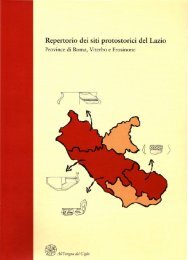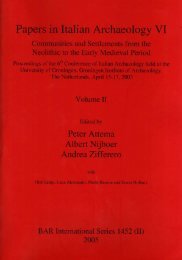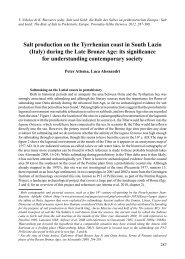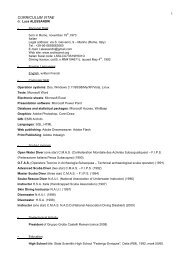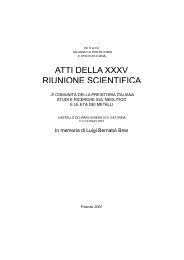THE CARTA ARCHEOLOGICA DI NETTUNO - Archeonet.Org
THE CARTA ARCHEOLOGICA DI NETTUNO - Archeonet.Org
THE CARTA ARCHEOLOGICA DI NETTUNO - Archeonet.Org
You also want an ePaper? Increase the reach of your titles
YUMPU automatically turns print PDFs into web optimized ePapers that Google loves.
<strong>DI</strong>SCUSSION<br />
The carenated ciotola nr. 2, although its inclination is uncertain, may be similar to several<br />
examples from Valle Felici, 17 a context dated to the initial phase of the middle Bronze<br />
Age. 18 This site also yields a parallel for ciotola nr. 6; 19 Ciotola nr. 9 is similar to typ 179<br />
in Aspetti, dated to the middle Bronze Age 2A. 20<br />
Rim fragment nr. 10 can also be ascribed to a type from Aspetti, 21 belonging to the Grotta Nuova facies<br />
and the southern protoappennine facies, dated to the second phase of the middle Bronze Age. Ciotole nrs. 8<br />
and 11 appear to be older; they can be attributed to type 359, 22 common in the Abruzzo and in north<br />
Campanian contexts of the first phase off the middle Bronze Age. Handle fragment nr. 13 is similar to an<br />
example from Vivara, Punta d’Alaca, 23 dated to the full phase of the middle Bronze Age; the carenated<br />
ciotole nrs. 12, 26 and 24 can be attributed to the same phase, to type 205B of the Grotta Nuova facies. 24<br />
Scodella nr. 14 is similar to type 37B in the same work 25 and is common in pre-appennine and appennine<br />
contexts; the ovoidal olla nr. 15 can be ascribed to type 411A. 26 Fragment nr. 18 belongs to type 477 27 and<br />
is considered common in the Grotta Nuova and the protoappennine facies, dating to the first phase of the<br />
middle Bronze Age; to that same phase fragments nrs. 19 and 20, both of type 500B 28 , should be ascribed.<br />
The ansa con sopraelevazione, probabilmente terminante a punta dates to the middle Bronze Age; this type<br />
finds a parallel in an example from Ponte S. Pietro Valle, trench B, 29 a context yielding fragments of the<br />
initial phase of the middle Bronze Age and the recent Bronze Age, 30 but also in a fragment from Lariano. 31<br />
Fragment nr. 26 has a clear parallel in the Villaggio delle Macine 32 , dated to middle<br />
Bronze Age 1B 33 ; other 1 st phase fragments include nr. 27, similar to an example from<br />
Candalla, Riparo della Roberta, layer c, 34 and fragment nr. 28, similar to a fragment from<br />
the Grotta dell’Orso at Sarteano. 35 Fragment 29 may indicate later frequentation; this<br />
fragment has a parallel from Tor San Giovanni, dated to the middle Bronze Age phase<br />
3. 36<br />
17 Bermond Montanari 1992, fig. 1, nrs. 25 and 27.<br />
18 Cocchi Genick 2002, 36, site 12; this complex is dated to the middle Bronze Age 1A.<br />
19 Bermond Montanari 1992, fig. 1, nr. 28; for the date see note 14 above.<br />
20 AA.VV. 1995, 122.<br />
21 AA.VV. 1995, 253, type 43.<br />
22 AA.VV. 1995, 220/221.<br />
23 Sector E, southeastern settlement area; see Damiani et al. 1984, fig. 4C, n. 3. Cocchi Genick considers<br />
this type to be a variant of type 496, dated to the second phase of the middle Bronze Age and common in<br />
the Grotta Nuova facies and in Tyrrhenean, Adriatico and Alto Jonio-contexts of the protoappennine facies.<br />
24 AA.VV. 1995, 138.<br />
25 AA.VV. 1995, 46.<br />
26 AA.VV. 1995, 243.<br />
27 AA.VV. 1995, 281.<br />
28 AA.VV. 1995, 294.<br />
29 Negroni Catacchio 1981, fig. 105, nr. 18.<br />
30 Cocchi Genick 2002, 41 (MBA2A).<br />
31 Guidi 1981, fig. 5, nr. 5.<br />
32 Chiarucci 1985, fig. 1, nr. 2.<br />
33 Cocchi Genick 2001, 207, type 279.<br />
34 Cocchi Genick 1984, fig. 1, nr. 1. In AA.VV 1995, 132, the type is considered to be a variant of type<br />
195, common in the Grotta Nuova facies and the protoappennine, dated to the first phase of the middle<br />
Bronze Age.<br />
35 Cremonesi 1968, fig. 12, n. 10. In AA.VV 1995, 178, the type is considered to be a variant of type 277,<br />
common in the Grotta Nuova facies and the Adriatic and Tyrrhenian protoappennine groups, dated to the<br />
first phase of the middle Bronze Age.<br />
36 Dottarelli et al. 1984, fig. 4, nr. 3.



